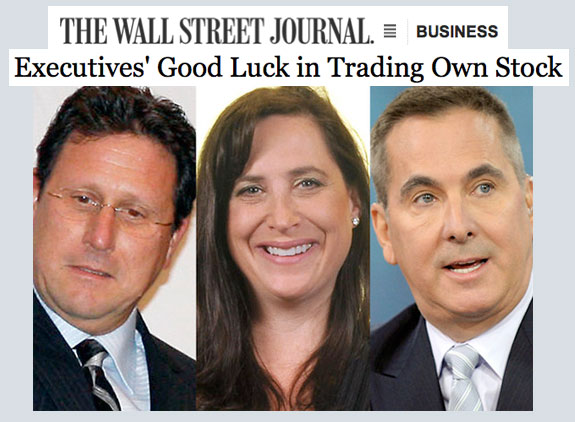Barlett & Steele Bronze Award Winners
“Inside Game: How Corporate Insiders Profit Ahead of the Public”
By Susan Pulliam, Rob Barry, Michael Siconolfi and Jean Eaglesham
The Wall Street Journal
The Wall Street Journal series on executive trading began with a casual conversation between one of the reporters and a long-time source.
The source mentioned a large trade by an executive that had come just days before the company announced bad news, raising questions about whether the executive had timed the trade to avoid the drop in his company’s shares that followed the announcement.
Trading by corporate executives in their own company stock, especially through pre-set plans, had received some attention years ago by academics. Now, the Journal decided to dig into the issue and examine whether some executives appeared to be abusing rules set up by regulators to allow them to trade.
Armed with the tip and the academic research, Journal reporters set to work trying to broaden the story.
As in many investigative projects that proceed from anecdotes, the next step in the reporting process was to identify the universe. How widely could reporters cast their net?
For decades, the trades by these insiders were reported on paper forms and inaccessible to analysis by computers. However, in 2003, the SEC began requiring insiders to disclose their trades in a special digital format that can be easily processed by computers.There are three groups that federal law says have such an intimate relationship with the companies whose stock they hold that they are considered “insiders,” and required to disclose their trades to the U.S. Securities and Exchange Commission. They include senior corporate executives, members of the boards of directors and shareholders with an extremely significant ownership stake.
Journal reporters set to work writing a series of programs that downloaded those digitized filings from the SEC and processed them into a database. In the end, the newspaper parsed several million forms containing about 2,500,000 open-market trades between 2004 and the end of 2012.
With that many trades, it was difficult to know which to focus on. Reporters needed to develop a methodology that would allow them to slice out interesting trades.
They decided to focus on market-moving events that occurred as a result of the disclosure of material information. In particular, reporters were searching for news that could have been known by insiders before it was announced.
This, it seemed, most closely matched the definition of “insider trading,” which states that everyone – not just corporate insiders – is prohibited from buying or selling stock on the basis of material, non-public information.
To find material news events, reporters turned to another dataset available via the SEC.
When companies disclose important information, like earnings forecasts, resignations of key officers or other major business events, they’re required to file notice with the SEC using a document known as a form 8-K.
Like insider trades, these documents are indexed and made available via the SEC’s website. Between 2004 and 2012, more than 20,000 companies reported 824,764 such announcements to the agency.
Reporters took these thousands of announcements and paired them with the database of insider trades, looking in particular for corporate executives who traded in the weeks before making news.
To be sure, many thousands of such events are innocuous, and it’s not possible to determine which of the more than 800,000 disclosures contained negative or positive information.
However, these releases are carefully scrutinized by thousands of investors around the world. When they contain major news, they can have a dramatic and nearly instantaneous effect on company stock price.
Reporters identified releases that occurred on the same day that company stock prices showed such dramatic shifts. While not all the changes in price were due to the specifics of the filing, extensive spot-checking revealed that in most cases when disclosures were followed by significant price changes, the events were linked.
The pattern of trading by executives before the news was striking:
Among 20,237 executives who traded their own company’s stock during the week before the news releases, 1,418 had average gains (or avoided losses) before price moves of more than 10%. That was close to double the 786 who saw the stock they traded move against them that much.
Though the statistics were compelling, it turned out that in some cases, executive trades were highly profitable, but didn’t seem particularly improbable. For example, any Apple executive who purchased stock in the company for years would have made an extremely profitable trade, and similarly, any newspaper executive who sold stock since the mid-2000s would have made a killing.
In order to identify the trades that were both highly profitable and extremely lucky, reporters used a statistical tool called a Monte Carlo simulation.
The simulation worked by sprinkling executives’ trades at random over the stock they were trading and counting the number of times the random trades’ returns were as good as – or better than – those actually achieved by the executive.
By performing this process several trillion times, reporters were able to identify hundreds of executives whose trading before news was not only profitable, but also immensely fortuitous.
Reporters Susan Pulliam and Rob Barry set to work studying these trades.
They found Jerrold Rosenbaum and his daughter, Beth Angelo, the founder and a top executive of Body Central Corp., who sold about $2.9 million of stock just days before the company’s price plunged more than 48% after a negative earnings report.
They turned up Samuel Gillespie, the general counsel of Cobalt International Energy Inc., who sold $9.8 million of the drilling company’s stock in the weeks before it reported the abandonment of a drilling operation in Africa and reported a quarterly loss.
And they found Raymond Zinn, chief executive at semiconductor Micrel Inc., who had three different sets of profitable trades before news in 2007, 2008 and 2010.
In reviewing the trades, reporters discovered an interesting pattern: Many of the sales before bad news were made under automatic trading plans.
Established by the SEC at the start of the last decade as a way for executives to diversify holdings while in possession of material information, trading plans allow insiders to sell their stock even when they know bad news is about to hit.
The plans are shrouded in secrecy, and executives don’t even have to disclose their existence.
When executives do choose to disclose they’ve used a plan, that fact is usually contained in a footnote on the insider trading forms filed with the SEC.
In recent years, academics and other experts have questioned whether some insiders use these plans to disguise opportunistic trading.
To test this hypothesis, the Journal carved out the trades executives said were planned and performed a test: Did the trading that followed a regular, clearly planned pattern fare better or worse than the trading that appeared more irregular?
The Journal found that executives who dipped in and out of their stock at irregular intervals were much likelier to record better gains than executives whose trades came at evenly spaced intervals.
The paper found that among executives who reported trading under a plan the week before news, one of every 33 who dipped in and out posted returns of more than 20% (or avoided comparable losses). By contrast, just one in 117 executives whose trades occurred at the same time each year did that well.
FIVE TIPS
There were several broader journalistic lessons illustrated through this project:
1)Question long-standing practices: Just because something has become accepted practice in an industry doesn’t mean it isn’t a story. Some of the best investigative stories come from digging in to an issue that is has had chronic problems but has become standard operating procedure anyway.
2) Take the long view: Consider holding off writing a quick hit on a story if it ties into a bigger issue that can be broadened. Persevere if it’s a meaty enough topic with potential impact.
3) Cultivate and develop good sources: For most reporters, the best investigative stories come through tips from trusted, long-time sources. You don’t need a lot of them, but a handful of what we call “high value” contacts can be a well that you can return to again and again for ideas about where to dig. No amount of time or effort developing these kinds of sources can be too much.
4) Seek out ways to smartly use data: Reporters like the Journal’s Rob Barry have developed over time a particular expertise in finding, assembling and analyzing data, both as a launching pad for projects and to bolster existing stories.
5) Be extra vigilant in vetting: With investigative projects often taking time– involving many interviews, much data and sometimes multiple reporters–it’s particularly important to develop a sound system to double-check accuracy. Getting anything wrong, even a small detail, could puncture great reporting efforts.











